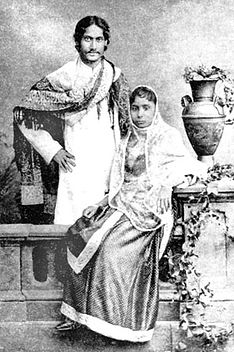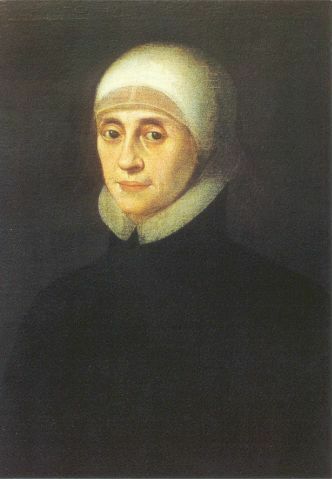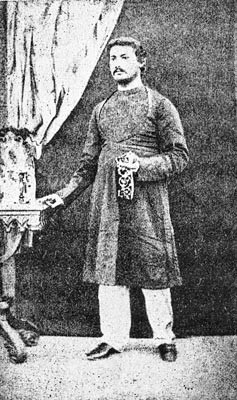|
Mrinalini Devi
Mrinalini Devi (1 March 1874 – 23 November 1902) was a translator and the wife of Nobel laureate poet, philosopher, author and musician Rabindranath Tagore. She was from the Jessor district, where her father worked at the Tagore estate. In 1883, at the age of nine, she married Tagore. Early life Mrinalini Devi was born to Benimadhob Roy Choudhury and Dakshayoni at Phultala village, in Jessor district of Bengal Presidency in British India (present-day Bangladesh). Her exact date of birth is not known. According to one estimate of a biographer, she was born on 1 March 1874. Another gave her birth as 1872. Before her marriage, Mrinalini Devi was known as Bhabatarini. However, it is unknown whether it was her formal name or nickname. She studied until Class I in the local village school. Her father worked at the Tagore estate. Marriage to Rabindranath Tagore The ''paka dekha'', a ritual in which members of the groom's family come to see the bride, was performed by Rabindran ... [...More Info...] [...Related Items...] OR: [Wikipedia] [Google] [Baidu] |
Jessore District
Jessore District (Bengali: যশোর, pronounced Jaw-shore, Anglicised: Jessore), officially spelled Jashore District from April 2018, is a district in the southwestern region of Bangladesh. It is bordered by India to the west, Khulna District and Satkhira District to the south, Khulna and Narail to the east, and Jhenaidah District and Magura District to the north. Jessore is the capital of the district. Jessore district was established in 1781. It consists of 8 municipalities, 8 upazilas, 92 unions, 1329 mouzas, 1477 villages and 120 mahallas. The upazilas are: Abhaynagar Upazila, Bagherpara Upazila, Chaugachha Upazila, Jessore Sadar Upazila, Jhikargachha Upazila, Keshabpur Upazila, Manirampur Upazila, and Sharsha Upazila. The district produces a variety of crops year-round. Date sugar, called ''patali'', is made from the sap of locally grown date trees. It is cooked, thickened and crystallised using a traditional method. Patali is mainly produced in Khajura, but many d ... [...More Info...] [...Related Items...] OR: [Wikipedia] [Google] [Baidu] |
Kadambari Devi
Kadambari Devi (5 July 1859 – 21 April 1884) was the wife of Jyotirindranath Tagore and daughter-in-law of Debendranath Tagore. She was ten years younger than her husband, whom she married on 5 July 1868 (২৫শে আষাঢ়, ১২৭৫ বঙ্গাব্দ), at the age of nine. Her husband arranged for her to be educated. She was nearly the same age as her brother-in-law Rabindranath Tagore being only two years older than him. She inspired young Rabindranath in composing many of his poems with her creative feedback and comments. She was also a good friend and playmate. She was one of the women who played a very important part in his life. Her relationship with Tagore was controversial and had elements of tragedy. For reasons that are not known, she committed suicide on 21 April 1884, four months after Rabindranath Tagore married. The Tagore family always remained silent about her suicide. Rumors of family problems having led to her suicide have circulated. A ... [...More Info...] [...Related Items...] OR: [Wikipedia] [Google] [Baidu] |
Veranda
A veranda or verandah is a roofed, open-air gallery or porch, attached to the outside of a building. A veranda is often partly enclosed by a railing and frequently extends across the front and sides of the structure. Although the form ''verandah'' is correct and very common, some authorities prefer the version without an "h" (the ''Concise Oxford English Dictionary'' gives the "h" version as a variant and '' The Guardian Style Guide'' says "veranda not verandah"). Australia's ''Macquarie Dictionary'' prefers ''verandah''. Architecture styles notable for verandas Australia The veranda has featured quite prominently in Australian vernacular architecture and first became widespread in colonial buildings during the 1850s. The Victorian Filigree architecture style is used by residential (particularly terraced houses in Australia and New Zealand) and commercial buildings (particularly hotels) across Australia and features decorative screens of wrought iron, cast iron "lace" or ... [...More Info...] [...Related Items...] OR: [Wikipedia] [Google] [Baidu] |
Mark Twain
Samuel Langhorne Clemens (November 30, 1835 – April 21, 1910), known by his pen name Mark Twain, was an American writer, humorist, entrepreneur, publisher, and lecturer. He was praised as the "greatest humorist the United States has produced", and William Faulkner called him "the father of American literature". His novels include ''The Adventures of Tom Sawyer'' (1876) and its sequel, ''Adventures of Huckleberry Finn'' (1884), the latter of which has often been called the " Great American Novel". Twain also wrote ''A Connecticut Yankee in King Arthur's Court'' (1889) and '' Pudd'nhead Wilson'' (1894), and co-wrote The Gilded Age: A Tale of Today (1873) with Charles Dudley Warner. Twain was raised in Hannibal, Missouri, which later provided the setting for ''Tom Sawyer'' and ''Huckleberry Finn''. He served an apprenticeship with a printer and then worked as a typesetter, contributing articles to the newspaper of his older brother Orion Clemens. He later became a river ... [...More Info...] [...Related Items...] OR: [Wikipedia] [Google] [Baidu] |
Sanskrit
Sanskrit (; attributively , ; nominally , , ) is a classical language belonging to the Indo-Aryan branch of the Indo-European languages. It arose in South Asia after its predecessor languages had diffused there from the northwest in the late Bronze Age. Sanskrit is the sacred language of Hinduism, the language of classical Hindu philosophy, and of historical texts of Buddhism and Jainism. It was a link language in ancient and medieval South Asia, and upon transmission of Hindu and Buddhist culture to Southeast Asia, East Asia and Central Asia in the early medieval era, it became a language of religion and high culture, and of the political elites in some of these regions. As a result, Sanskrit had a lasting impact on the languages of South Asia, Southeast Asia and East Asia, especially in their formal and learned vocabularies. Sanskrit generally connotes several Old Indo-Aryan language varieties. The most archaic of these is the Vedic Sanskrit found in the Rig Veda, a colle ... [...More Info...] [...Related Items...] OR: [Wikipedia] [Google] [Baidu] |
Loreto House
Loreto House was established in 1842 in Kolkata, by the Sisters of Loreto belonging to the institute of the Blessed Virgin Mary. It is the oldest and the first Loreto institution to be established in India and was one of the few all-girls Catholic schools of that time. The School started with sixty students who were taught at a house where nuns lived under Mother Delphine Hart, assisted by Sr. Teresa Mons and Sr. Martina McCann. The School was initially established for the education of Catholic girls. However, it has long admitted students of many religious beliefs. Currently it is headed by Sister Phyllis. The school is known for hosting annual events like 'We Care' and their popular bi-annual 'Big Fete'. alumni *Jayashree Mohta – Chairperson of the Sarala Birla Group *Shobhana Bhartia –Chairperson, Editorial Director Hindustan Times(HT) Media Group *Abha Narain Lambah – Conservation architect * Riddhima Ghosh – Bengali Actress *Raima Sen ... [...More Info...] [...Related Items...] OR: [Wikipedia] [Google] [Baidu] |
Hemendranath Tagore
Hemendranath Tagore (1844–1884), Debendranath Tagore's third son, is notable for being the first Brahmo as the first child born in 1844 to any of the original 21 Brahmos who swore the First Brahmo Covenant on 21 December 1843 at Calcutta (now Kolkata). An intensely private person, he was also well known as the strict disciplinarian entrusted with the responsibility of looking after the education of his younger brothers in addition to being administrator for his large family estates. He was also the constant spiritual companion to his father Debendranath Tagore who founded Brahmoism and, despite his youth, he acted as the mediator between his father and the seniors of the ''Tattwabodhini Sabha''. At the time of the First Brahmo Schism of 1865, he was responsible for expelling the non-Brahmin workers from the Calcutta Brahmo Samaj. The Adi Dharm religion is founded exclusively on his philosophy and is today the largest development from Brahmoism with over 8 million adherents ... [...More Info...] [...Related Items...] OR: [Wikipedia] [Google] [Baidu] |
Atmaram Pandurang
Atmaram Pandurang or Atmaram Pandurang Turkhadekar (or just Turkhad in English publications) (1823 – 26 April 1898) was an Indian physician and social reformer who founded the Prarthana Samaj and was one of the two Indian co-founders (the other being Sakharam Arjun) of the Bombay Natural History Society. A graduate of Grant Medical College, he was a brother of Dadoba Pandurang (9 May 1814 – 17 October 1882), a scholar of Sanskrit and Marathi. Atmaram Pandurang served briefly as sheriff of Bombay in 1879. Atmaram was born to Pandurang Yeshwant and Yashodabai. He went to the Elphinstone Institution (along with fellow student Dadabhai Naoroji) where he studied mathematics under Bal Gangadhar Shastri Jambhekar (1812-1846). He then joined the newly opened Grant Medical College and was in the first batch of students that included Dr Bhau Daji Lad and joined on 1 November 1845.With a diploma, he worked in Bhiwandi, running a smallpox vaccination campaign. He later helped frame Arti ... [...More Info...] [...Related Items...] OR: [Wikipedia] [Google] [Baidu] |
Bengali Calendar
The Bengali Calendar or Bangla Calendar ( bn, বঙ্গাব্দ , , Baṅgābda), colloquially ( bn, বাংলা সন, Baṅgla Śon), is a solar calendar used in the Bengal region of the Indian subcontinent. A revised version of the calendar is the national and official calendar in Bangladesh and an earlier version of the calendar is followed in the Indian states of West Bengal, Tripura and Assam. The New Year in the Bengali calendar is known as ''Pohela Boishakh''. The Bengali era is called ''Bengali Sambat'' (BS) or the ''Bengali year'' ( ''Bangla Sôn'', ''Bangla sal'', or ''Bangabda'') has a zero year that starts in 593/594 CE. It is 594 less than the AD or CE year in the Gregorian calendar if it is before ''Pôhela Bôishakh'', or 593 less if after ''Pôhela Bôishakh''. The revised version of the Bengali calendar was officially adopted in Bangladesh in 1987. Among the Bengali community in India, the traditional Indian Hindu calendar continues to be in use ... [...More Info...] [...Related Items...] OR: [Wikipedia] [Google] [Baidu] |
Agrahayana
Agrahāyaṇa or Mārgaśīrṣa, (Hindi: अगहन - agahana; मार्गशीर्ष - Mārgaśirṣa) is a month of the Hindu calendar. In India's national civil calendar, ''Agrahāyaṇa'' is the ninth month of the year, beginning on 16 December 2021 and ending on 13 January 2022. But In Hindu , Agrahayana or Margaseerisha will starts on November 22. Mārgaśīrṣa means: related to Mṛgaśiras - the Nakṣatra ( asterisms) known since Vedic times. In Tamil, Mārgasīrsa is also known as Margazhi. In lunar religious calendars, Agrahāyaṇa may begin on either the new moon or the full moon around the same time of year, and is usually the 9th month of the year. In solar religious calendars, Agrahāyaṇa/Maarkazhi begins with the Sun's entry into Scorpio, and is the 9th month of the year. Festivals Vaikuṇṭha Ekādaśī, the Ekādaśī (i.e. 11th lunar day) of this Mārgaśīṣa month, is celebrated also as ''Mokṣadā Ekādaśī''. The 10th Canto, ... [...More Info...] [...Related Items...] OR: [Wikipedia] [Google] [Baidu] |
Brahmo Samaj
Brahmo Samaj ( bn, ব্রহ্ম সমাজ, Brahmô Sômaj, ) is the societal component of Brahmoism, which began as a monotheistic reformist movement of the Hindu religion that appeared during the Bengal Renaissance. It was one of the most influential religious movements in India and made a significant contribution to the making of modern India. It was started at Calcutta on 20 August 1828 by Raja Ram Mohan Roy and Dwarkanath Tagore as reformation of the prevailing Brahmanism of the time (specifically Kulin practices) and began the Bengal Renaissance of the 19th century pioneering all religious, social and educational advance of the Hindu community in the 19th century. Its Trust Deed was made in 1830 formalising its inception and it was duly and publicly inaugurated in January 1830 by the consecration of the first house of prayer, now known as the Adi Brahmo Samaj. From the ''Brahmo Samaj'' springs Brahmoism, the most recent of legally recognised religions in India an ... [...More Info...] [...Related Items...] OR: [Wikipedia] [Google] [Baidu] |
Devendranath Tagore
Debendranath Tagore (15 May 1817 – 19 January 1905) was an Indian Hindu philosopher and religious reformer, active in the Brahmo Samaj (earlier called Bhramho Sabha) ("Society of Brahma", also translated as ''Society of God''). He joined Brahmo samaj in 1842. He was the founder in 1848 of the Brahmo religion, which today is synonymous with Brahmoism. Born in Shilaidaha, his father was the industrialist Dwarkanath Tagore; he himself had 14 children, many of whom, including Nobel Prize, Nobel-prize winning poet Rabindranath Tagore, made significant artistic or literary contributions to society. Thakur Bari (House of Tagores) Debendranath Tagore was born to the Tagore family in Jorasanko, popularly known as Jorasanko Thakur Bari in North-western Kolkata, which was later converted into a campus of the Rabindra Bharati University. The Tagore family, with over three hundred years of history,Deb, Chitra, pp 64–65. has been one of the leading families of Calcutta, and is regarded as ... [...More Info...] [...Related Items...] OR: [Wikipedia] [Google] [Baidu] |








